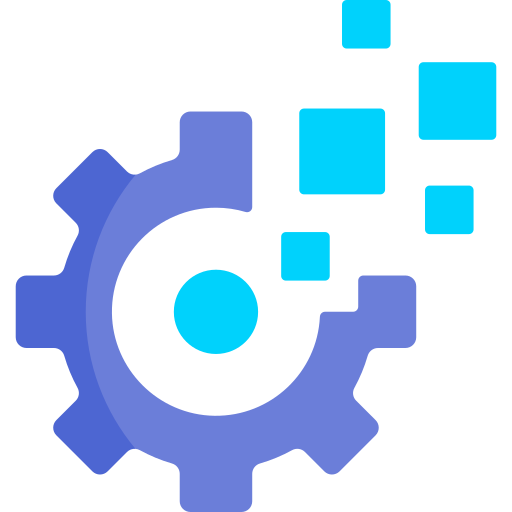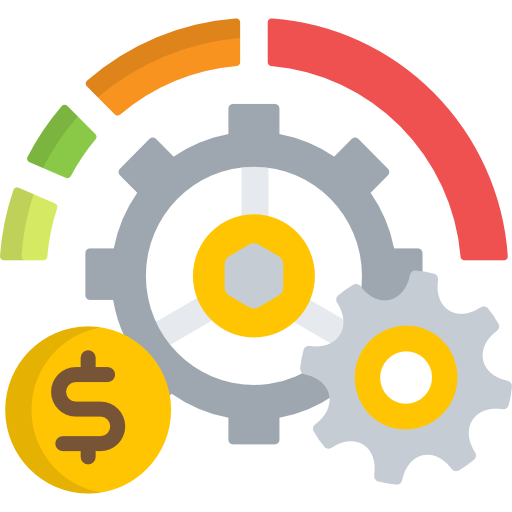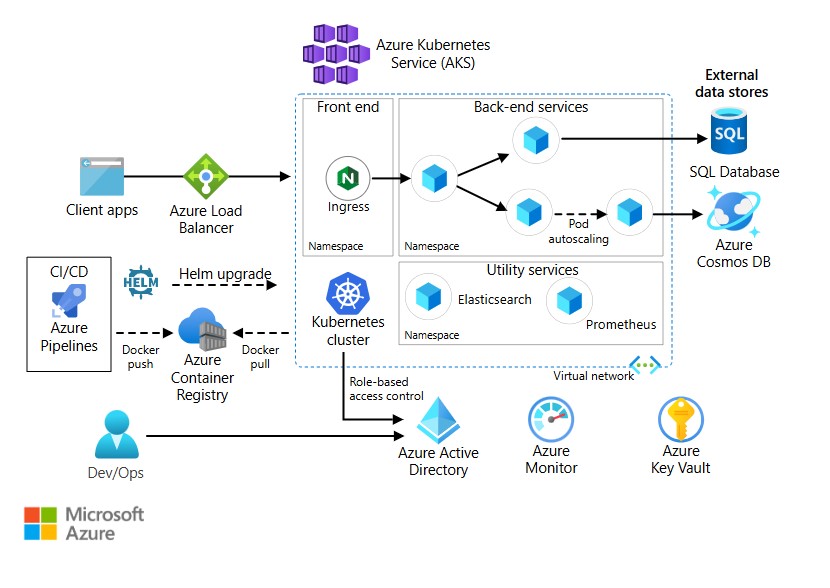Domain-Driven Design (DDD) and Microservices Architecture are two popular approaches in software development, each with its unique strengths and use cases. While they can be used independently, they often complement each other to create robust and scalable systems.

What's Domain-Driven Design (DDD)?
Domain-Driven Design (DDD) is a software development approach that foucs on modeling a software system around the business domain. It focuses on understanding the underlying business processes and translating them into a software model.

Key concepts in DDD include:
- Bounded Contexts: Isolating parts of the domain that have distinct models and terminology.
- Aggregates: Groups of related entities that are treated as a single unit.
- Value Objects: Objects that represent values rather than entities.
- Domain Events: Notifications of significant changes within the domain.
When to Use Domain-Driven Design?
DDD is particularly suitable for applications with complex business domains and a need for long-term maintainability. It helps to ensure that the software aligns closely with business processes and is adaptable to changes.
DDD architecture might be the best fit:
- When you need to deeply understand and model a complex business domain.
- When you want to ensure that the software aligns closely with business processes.
- When you are building a system with a focus on long-term maintainability and evolvability.
- When your applications have complex business logic and relationships between entities.
- With Systems that need to be easily understood, modified, and extended over time (Long-term maintainability).
- With Applications that must closely align with the underlying business operations.
DDD provides a framework for understanding and modeling the business domain
Domain-Driven Design (DDD) Pros and Cons
Pros:
- Improved understanding of the business domain: DDD forces developers to deeply understand the business processes and terminology, leading to better-aligned software.
- Enhanced maintainability: By modeling the software around the business domain, it becomes easier to understand, modify, and extend.
- Increased flexibility: DDD promotes loose coupling between components, making the system more adaptable to changes.
- Better collaboration: DDD fosters collaboration between business experts and developers, ensuring that the software meets the needs of the business.
Cons:
- Steeper learning curve: DDD requires a significant investment of time and effort to learn and apply effectively.
- Potential for complexity: If not implemented carefully, DDD can introduce complexity into the system.
- Increased upfront costs: The initial design and development phase may be more time-consuming and expensive compared to other approaches.
The best approach for a particular project depends on the specific requirements, team expertise, and desired outcomes.
Domain-Driven Design (DDD) Real Use Case: Healthcare
Healthcare systems often involve complex business domains with intricate relationships between entities (patients, doctors, diagnoses, treatments, etc.). DDD can be particularly effective in modeling these domains.
- Bounded Contexts: Separate bounded contexts could include "Patient Management," "Billing," and "Clinical Decision Support."
- Aggregates: A "Patient" aggregate might include related entities like "Medical History," "Insurance Information," and "Appointments."
- Value Objects: "Date of Birth," "Blood Type," and "Diagnosis Code" could be value objects.
By applying DDD, healthcare systems can ensure that the software accurately reflects the underlying business processes and terminology, improving efficiency, accuracy
Why DDD for Healthcare?
DDD is particularly well-suited for healthcare systems due to the complex and often evolving nature of the domain. By modeling the software around the business processes, DDD can:
- Ensure that developers have a deep understanding of the healthcare domain.
- Create software that is easier to understand, modify, and extend.
- Adapt to changes in healthcare regulations and practices.
- Improve collaboration between healthcare professionals and developers.
 DDD Processes and Step-by-Step Implementation
DDD Processes and Step-by-Step Implementation
-
Domain Exploration:
- Identify core concepts: Determine the key entities and relationships within the healthcare domain (e.g., patients, doctors, appointments, diagnoses).
- Uncover business rules: Understand the underlying business processes and rules that govern the domain (e.g., patient eligibility for treatments, billing regulations).
-
Model Construction:
- Create bounded contexts: Divide the domain into separate contexts based on distinct models and terminology (e.g., "Patient Management," "Billing").
- Define aggregates: Group related entities into aggregates to ensure consistency and maintainability (e.g., a "Patient" aggregate might include "Medical History" and "Appointments").
- Identify value objects: Define value objects to represent immutable values (e.g., "Date of Birth," "Diagnosis Code").
-
Design and Development:
- Implement domain models: Translate the domain model into software components using a suitable programming language and framework.
- Ensure consistency: Enforce consistency within aggregates and across bounded contexts using appropriate design patterns and techniques.
- Leverage domain events: Use domain events to communicate changes within the domain and trigger relevant actions (e.g., notifying a patient about an upcoming appointment).
-
Iterative Refinement:
- Gather feedback: Continuously gather feedback from domain experts to refine the domain model and ensure it accurately reflects the business needs.
- Adapt to changes: Be prepared to adapt the domain model as the business requirements evolve.
Implementation Best Practices
- It's recommened to involve domain experts by collaborating closely with healthcare professionals to gain a deep understanding of the domain.
- Begin with a simplified domain model (Start Small) and gradually refine it as you learn more (Iterate).
- Use a ubiquitous language and establish a shared vocabulary between developers and domain experts to avoid misunderstandings.
- Consider using modeling tools to visualize and communicate the domain model.
- Focus on bounded contexts and clearly define and isolate bounded contexts to manage complexity.
- Use domain events to communicate changes within the domain and trigger relevant actions.
Architecture Design Best Practices
Below are the key components that you should put it into your consideration when visualize the architecture design for DDD
- Bounded Contexts: Isolated domains with distinct models and terminology.
- Aggregates: Groups of related entities treated as a single unit.
- Value Objects: Immutable objects representing values.
- Domain Events: Notifications of significant changes within the domain.
- Domain Services: Stateless services encapsulating business logic.
- Repositories: Interfaces for accessing and persisting domain objects.
 Team Selection for DDD
Team Selection for DDD
Before you start implemting a new project you have to select your team based on specific qualifcations as the following:
Required Qualifications:
Yout team members should have
- A strong domain konwldge and a deep understanding of the specific domain to effectively model and implement the business processes.
- A experience with DDD principles and practices, including bounded contexts, aggregates, value objects, and domain events.
- A software development skills in a suitable programming language (e.g., Java, C#, Python) and object-oriented design principles.
- A communication and collaboration skills and the ability to work closely with domain experts and other team members to ensure alignment and effective communication.
Team Composition:
Your team should includes the below roles
- Domain experts: Domain professionals who can provide insights and guidance on the business domain.
- DDD architects: Experienced developers who can lead the design and implementation of the domain model.
- Software developers: Skilled developers to implement the domain model and related components.
Knowledge Requirements for DDD
- Domain modeling: Understanding of domain-driven design principles, including bounded contexts, aggregates, value objects, and domain events.
- Object-oriented programming: Proficiency in object-oriented programming concepts and design patterns.
- Business analysis: Ability to analyze business processes and requirements to create effective domain models.
- Communication and collaboration: Strong communication and collaboration skills to work with domain experts and other team members.
While specific programming languages and frameworks can vary, a solid understanding of object-oriented programming principles is essential.
 Technology Requirements for DDD
Technology Requirements for DDD
Programming Languages:
- Java: A popular choice for enterprise applications, offering a rich ecosystem of frameworks and libraries.
- C#: Another popular language, especially for .NET-based applications.
- Python: A versatile language suitable for a wide range of applications, including DDD.
Frameworks:
- Spring Framework (Java): A comprehensive framework providing various components for DDD, including dependency injection, data access, and transaction management.
- .NET Core (C#): A cross-platform framework offering similar features to Spring, with a focus on performance and scalability.
- Django (Python): A high-level web framework that can be used for DDD applications.
Modeling Tools:
- UML: Unified Modeling Language can be used to visualize and communicate the domain model.
- Domain-specific modeling tools: Specialized tools like Enterprise Architect or Visual Paradigm can be helpful for complex domains.
Data Persistence:
- Relational databases: Popular choices include MySQL, PostgreSQL, and Oracle.
- NoSQL databases: Options include MongoDB, Cassandra, and Neo4j for specific use cases.
Tools Required for DDD
- Modeling tools: UML, Enterprise Architect, Visual Paradigm
- Version control: Git, SVN
- Integrated development environment (IDE): Eclipse, IntelliJ IDEA, Visual Studio
- Testing frameworks: JUnit, NUnit, pytest
- Continuous integration/continuous delivery (CI/CD) tools: Jenkins, GitLab CI/CD, Azure DevOps
 DDD Costs
DDD Costs
The specific costs can vary depending on factors such as the complexity of the application, team size, and technology choices.
- DDD can require a significant upfront investment in understanding the business domain and designing a suitable model.
- Team members may need to invest time in learning DDD principles and practices.
- Complex domain models can increase development time and costs.
While DDD may have higher upfront costs, it can lead to improved maintainability and reduced long-term costs.
What's Microservices Architecture?
Microservices architecture is a design approach where a large application is decomposed into smaller, independent services that communicate with each other using well-defined APIs.

Key characteristics of microservices include:
- Decentralized Governance: Each service is independently developed and deployed.
- Bounded Contexts: Aligned with DDD, microservices often map to bounded contexts.
- Technology Heterogeneity: Different technologies can be used for different services.
- Continuous Delivery: Independent deployment and scaling of services.
When to Use Microservices?
Microservices architecture offers a way to decompose the system into smaller, manageable components.
Microservices architecture might be the best fit:
- When you have a large, complex application that can be decomposed into smaller, independent services.
- When you need to scale the application horizontally to handle increasing load.
- When you want to enable faster development and deployment cycles.
Microservices Architecture Pros and Cons
Pros:
- Scalability: Each microservice can be scaled independently, allowing the system to handle increasing load.
- Resilience: If one microservice fails, the others can continue to function, improving system reliability.
- Technology heterogeneity: Different technologies can be used for different microservices, enabling the use of the best tool for the job.
- Faster development and deployment: Microservices can be developed and deployed independently, accelerating time-to-market.
- Improved fault isolation: Faults are contained within individual microservices, reducing the impact on the entire system.
Cons:
- Increased complexity: Managing and coordinating multiple microservices can be challenging.
- Distributed systems challenges: Communication and coordination between microservices can introduce latency and complexity.
- Increased operational overhead: Managing and monitoring multiple microservices requires additional effort and resources.
- Potential for inconsistencies: Ensuring consistency across multiple microservices can be difficult.
- Higher development costs: The initial development and setup costs can be higher compared to a monolithic architecture.
The best approach for a particular project depends on the specific requirements, team expertise, and desired outcomes.
Microservices Architecture Real Use Case: E-Government
E-government platforms often involve a wide range of services, such as citizen registration, tax filing, and permit applications. Microservices architecture can be a suitable approach to decouple these services and enable independent development, deployment, and scaling.
- Individual Services: Services could include "Citizen Registration," "Tax Calculation," and "Document Verification."
- Communication: These services would communicate with each other using well-defined APIs, allowing for flexibility and scalability.
- Benefits: Microservices architecture can improve the resilience of e-government platforms, as failures in one service would not necessarily affect the entire system. It can also enable faster development and deployment of new features.
By adopting microservices architecture, e-government platforms can provide a more responsive and scalable experience for citizens, while also improving efficiency and reducing costs.
Why Microservices for E-Government?
Microservices architecture is well-suited for e-government platforms due to the diverse range of services and the need for scalability and flexibility. By breaking down the platform into smaller, independent services, microservices can:
- Improve scalability: Scale individual services to handle increasing load.
- Increase resilience: Isolate failures to a single service.
- Enable faster development: Develop and deploy services independently.
- Support technology heterogeneity: Use different technologies for different services.
 Microservices Processes and Step-by-Step Implementation
Microservices Processes and Step-by-Step Implementation
-
Service Identification:
- Break down services: Identify the core functionalities that can be isolated into separate services (e.g., "Citizen Registration," "Tax Calculation").
- Define APIs: Define clear APIs for each service to enable communication between them.
-
Service Development:
- Develop independently: Develop each service as a standalone unit using appropriate technologies.
- Ensure scalability: Design services to be scalable and able to handle increasing load.
-
Deployment and Orchestration:
- Deploy individually: Deploy each service to a suitable environment (e.g., cloud platform).
- Orchestrate communication: Use a service mesh or API gateway to manage communication between services.
-
Continuous Delivery:
- Automate deployment: Implement continuous delivery pipelines to automate the deployment of new versions of services.
- Monitor and test: Monitor the performance and health of services and conduct regular testing.
Implementation Best Practices
- Start small and incremental: Begin with a few core services and gradually add more as needed.
- Use a service mesh: Consider using a service mesh to simplify communication and management of microservices.
- Implement API gateways: Use API gateways to provide a unified interface for clients and manage traffic.
- Focus on autonomy: Ensure that each service is independently deployable and scalable.
The specific implementation details, such as the choice of technologies and frameworks, will depend on the project's requirements and constraints.
Architecture Design Best Practices
Below are the key components that you should put it into your consideration when visualize the architecture design for Microservices:
- Microservices: Small, independent services with well-defined APIs.
- API Gateway: A single entry point for clients, routing requests to the appropriate microservice.
- Service Discovery: Mechanism for services to discover each other and establish communication.
- Service Mesh: A layer of infrastructure that handles communication and service management.
- Data Management: Mechanisms for storing and managing data, including databases, message queues, and caches.
 Team Selection for Microservices
Team Selection for Microservices
Before you start implemting a new project you have to select your team based on specific qualifcations as the following:
Required Qualifications:
- Microservices experience: Experience with designing and developing microservices-based systems, including API design, communication protocols, and service orchestration.
- Distributed systems knowledge: Understanding of distributed systems concepts, such as fault tolerance, scalability, and consistency.
- Cloud platform expertise: Proficiency in cloud platforms (e.g., AWS, Azure, GCP) for deployment and management of microservices.
- DevOps skills: Knowledge of DevOps practices, including continuous integration, continuous delivery, and infrastructure as code.
Team Composition:
- Microservices architects: Experienced developers who can design and implement microservices-based systems.
- Software developers: Skilled developers to build and maintain individual microservices.
- DevOps engineers: Engineers responsible for infrastructure, deployment, and operations.
- Cloud architects: Experts in cloud platforms to design and manage cloud-based infrastructure.
Additional Considerations:
- Team size: The size of the team will depend on the complexity of the project and the available resources.
- Skill mix: Ensure that the team has a diverse range of skills to cover all aspects of the project.
- Communication and collaboration: Foster effective communication and collaboration among team members to ensure successful project outcomes.
- Agile methodologies: Consider using agile methodologies (e.g., Scrum, Kanban) to facilitate iterative development and adaptation to changing requirements.
Knowledge Requirements for Microservices
- Distributed systems: Understanding of distributed systems concepts, including fault tolerance, scalability, and consistency.
- API design: Knowledge of RESTful API design principles and best practices.
- Containerization: Familiarity with containerization technologies like Docker.
- Orchestration: Understanding of container orchestration platforms like Kubernetes.
- DevOps: Knowledge of DevOps practices, including continuous integration, continuous delivery, and infrastructure as code.
- Cloud platforms: Familiarity with cloud platforms like AWS, Azure, or GCP.
Experience with distributed systems and cloud-native technologies is highly beneficial.
 Technology Requirements for Microservices
Technology Requirements for Microservices
Programming Languages:
- Java: Widely used for microservices due to its mature ecosystem and performance.
- C#: Another popular choice, especially for .NET-based applications.
- Python: A versatile language suitable for microservices, offering frameworks like Flask and Django.
- Go: A modern language designed for concurrency and performance, making it a good fit for microservices.
Frameworks:
- Spring Boot (Java): A popular framework for building microservices, providing features like auto-configuration and dependency injection.
- ASP.NET Core (C#): A cross-platform framework for building microservices, offering similar features to Spring Boot.
- Flask (Python): A lightweight framework for building microservices.
- Go Kit (Go): A toolkit for building microservices in Go.
Containerization:
- Docker: A popular platform for packaging and running applications as containers.
- Kubernetes: A container orchestration platform for managing and scaling microservices.
Service Mesh:
- Istio: A popular service mesh for managing communication and traffic between microservices.
- Linkerd: Another service mesh option with a focus on simplicity and performance.
API Gateways:
- Kong: A popular API gateway for managing traffic, authentication, and rate limiting.
- Tyk: Another API gateway option with a focus on flexibility and scalability.
Data Management:
- Relational databases: Suitable for storing structured data.
- NoSQL databases: Can be used for unstructured or semi-structured data.
- Message queues: For asynchronous communication between microservices (e.g., RabbitMQ, Kafka).
- Caching: To improve performance and reduce load on databases.
Tools Required for Microservices
- Containerization: Docker, Kubernetes
- Service mesh: Istio, Linkerd
- API gateway: Kong, Tyk
- Service discovery: Consul, Eureka
- Configuration management: Ansible, Chef, Puppet
- Monitoring and logging: Prometheus, Grafana, ELK Stack
- Testing frameworks: JUnit, NUnit, pytest
- Continuous integration/continuous delivery (CI/CD) tools: Jenkins, GitLab CI/CD, Azure DevOps
-
Additional tools:
- Cloud platforms: AWS, Azure, GCP
- Messaging queues: RabbitMQ, Kafka
- Caching: Redis, Memcached
- Database tools: MySQL, PostgreSQL, MongoDB
 Microservices Costs
Microservices Costs
The specific costs can vary depending on factors such as the complexity of the application, team size, and technology choices.
- Initial setup and infrastructure: Setting up a microservices architecture can involve costs for infrastructure, containerization, and service mesh.
- Distributed systems challenges: Managing communication and coordination between microservices can introduce additional complexity and costs.
- Operational overhead: Monitoring, managing, and scaling multiple microservices can require more resources and expertise.
Lower upfront costs but higher operational overhead and potential for increased complexity.
Key Differences Summary
| Feature |
Domain-Driven Design |
Microservices Architecture |
| Focus |
Modeling the business domain |
Decoupling services |
| Granularity |
Can be applied at various levels (e.g., modules, subsystems) |
Typically focused on fine-grained services |
| Technology |
Agnostic to technology choices |
Often associated with polyglot persistence and cloud-native technologies |
| Deployment |
Can be monolithic or microservices |
Primarily microservices |
| Scalability |
Can be scalable, but might require refactoring for large-scale microservices |
Well-suited for horizontal scaling of individual services |
Conclusion: DDD vs. Microservices
Domain-Driven Design (DDD) and Microservices Architecture are powerful approaches to software development, each with its own strengths and weaknesses. While they can be used independently, they often complement each other to create robust and scalable systems.
- DDD excels at modeling complex business domains and ensuring that software aligns closely with business processes. It is particularly suitable for applications that require long-term maintainability and adaptability.
- Microservices are ideal for large, complex applications that can be decomposed into smaller, independent services. They offer scalability, resilience, and faster development and deployment cycles.
The best choice for a particular project depends on the specific requirements, team expertise, and desired outcomes. In many cases, a hybrid approach combining DDD and microservices can be the most effective solution.
By carefully considering the factors outlined in this guide, you can make informed decisions about whether to use DDD, microservices, or a combination of both for your software development projects.